The Samsung S85F with a QD-OLED panel is capable of surprising – and in a very positive way. Even before the tests, we did not think that in the case of TVs often referred to in the context of "panel lotteries", one could come across something that would benefit the user. Yet, in this case, particularly with the 55-inch version, it has fully succeeded. The QD-OLED panel, as expected from organic technology, offers near-perfect blacks and contrast in cinematic conditions. However, the difference lies in the way the colours are rendered – here it is simply exceptional. The colour gamut coverage is impressive, and after a slight calibration, the colours become almost exemplary. Motion fluidity is also at a very high level. The 120 Hz panel handles both sports and action films excellently. And if someone plans to connect a console to the S85F, they will receive a full set of advantages: low input lag, variable refresh rate, Game Bar, and full HDMI 2.1 support. In everyday use, we were supported by the Tizen system – closed, but extremely polished. It responds quickly, offers a rich selection of apps, and features like AirPlay and voice control make it hard to find anything more complete in this category. True, the S85F is not without its flaws. However, the balance of pros and cons is exceptionally favourable here. One could even get the impression that it is one of the best TVs in its price segment.
- Matching (Score)
- Our verdict
- TV appearance
- Where to buy
- Contrast and black detail
- HDR effect quality
- Factory color reproduction
- Color reproduction after calibration
- Smoothness of tonal transitions
- Image scaling and smoothness of tonal transitions
- Blur and motion smoothness
- Console compatibility and gaming features
- Input lag
- Compatibility with PC
- Viewing angles
- TV efficiency during daytime
- Details about the matrix
- TV features
- Apps
- Playing files from USB
- Sound
Samsung S85F OLED vs Philips OLED770
Direct compare
S85F / FAE / FAU
Available screen sizes: 55”
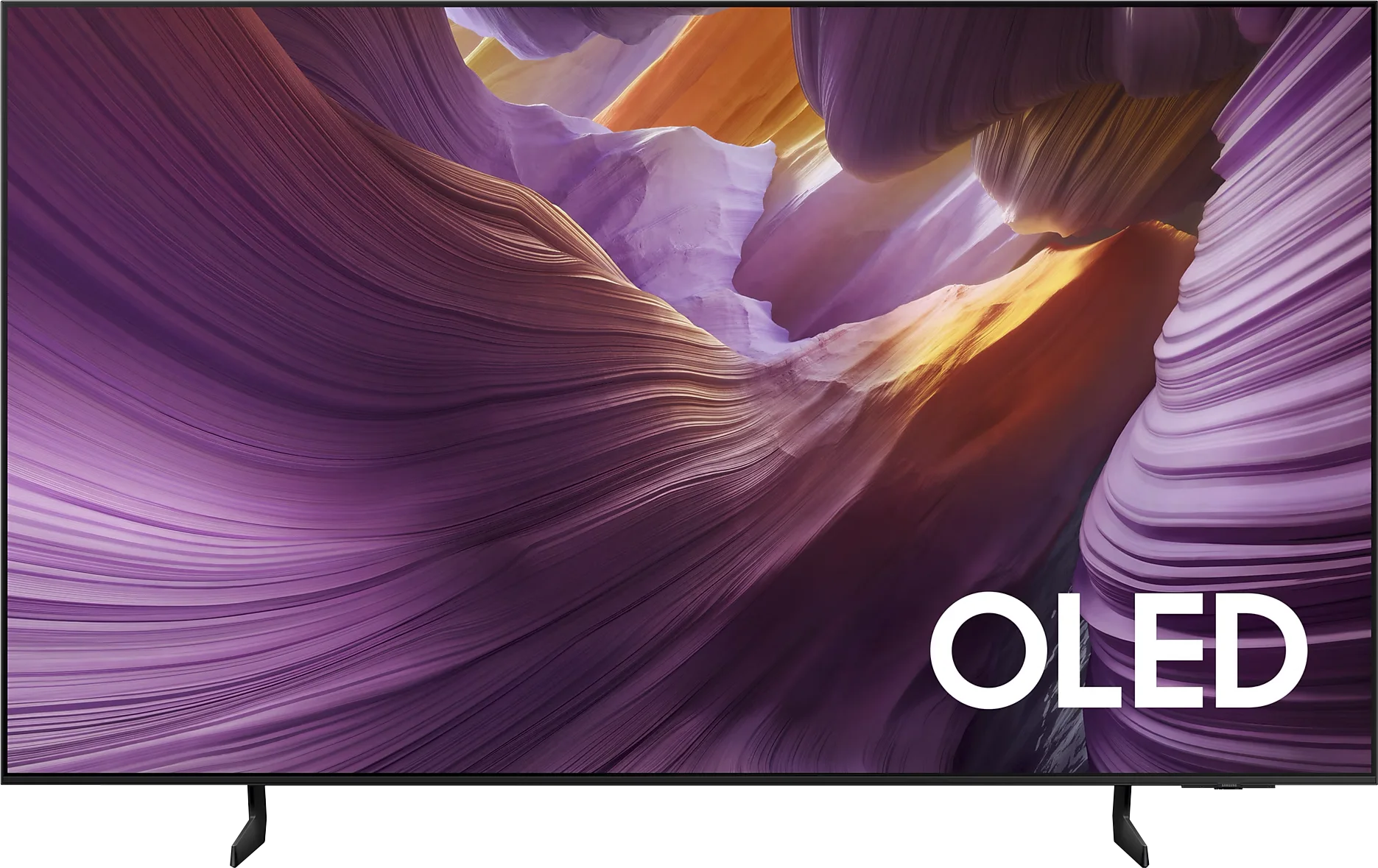

Panel type: QD-OLED
Resolution: 3840x2160
System: Tizen
Model year: 2025
Complete the survey to find out the result

Panel type: WRGB OLED
Resolution: 3840x2160
System: Titan OS
Model year: 2025
Complete the survey to find out the result

Overall rating
8.0
7.5
Movies and series in UHD quality
8.3
8.0
Classic TV, YouTube
9.0
8.6
Sports broadcasts (TV and apps)
8.8
8.4
Gaming on console
9.3
9.2
TV as a computer monitor
7.6
7.6
Watching in bright light
5.1
4.8
Utility functions
7.3
5.5
Apps
8.7
6.7
Sound quality
7.2
7.0
Complete the survey to find out what fits your preferences
Advantages
Outstanding black levels and contrast
Amazing colour palette coverage thanks to the QD-OLED panel
Great picture quality in SDR and HDR content
High colour accuracy after calibration
Very good motion smoothness – 120 Hz OLED panel
Rich set of features for gamers: VRR, Game Bar, low input lag
4 HDMI 2.1 ports with full 48 Gbps bandwidth
Advanced and smoothly operating Tizen system
Solar Remote with multiple capabilities
Excellent image quality typical of OLED – perfect blacks, infinite contrast
AmblightTV system
Support for multiple HDR formats including Dolby Vision and HDR10+
Great image quality after calibration
Decent viewing angles
Excellent motion smoothness – 120Hz OLED panel!
Many features for gamers: VRR, ALLM, Dolby Vision Gaming
Low input lag
4 HDMI 2.1 ports!
Disadvantages
No USB recording function and PiP
No Dolby Vision
Slight cherry black under very strong external light (not visible when watching in cinema conditions)
No HGiG function*
* This function disappeared with software update 1110.7 – we are monitoring this situation closely.
TitanOS has very few apps and has annoying bugs
The remote works on infrared
Not the best upscaling quality
Average reflection suppression – the screen behaves like a slightly dimmed mirror
Our verdict
Philips OLED770 is a television that stands out primarily for its picture quality – the characteristic perfect black and infinite contrast typical of OLEDs make even a regular evening of binge-watching a series feel like a small cinematic experience. After calibration, the colours gain naturalness and consistency, while details in dark scenes are separated from the lights with surgical precision. This is a screen that gives the feeling of engaging with premium-class technology, even though it is formally a budget OLED in Philips' portfolio. The second pillar on which the OLED770 stands very strong is gaming. Here, the manufacturer has really done their homework. VRR works up to 120 Hz, we have an automatic game mode (ALLM), and input lag in standard HDR10 or SDR modes at 120 Hz can drop to as low as 5 ms – these are results that will easily satisfy even the most demanding gamers. And finally, the Ambilight system – for many it’s a gadget, but during longer sessions, it truly makes a difference. The colourful LEDs behind the screen dynamically respond to what's happening in the game, and can pull you deeper into the virtual world. It’s precisely for this reason that one could risk saying that the OLED770 is one of the more interesting budget gaming TVs on the market.
However, not everything shines so brightly, because when we come to the Smart TV aspect… TitanOS is the biggest drawback of this model. Theoretically, we have everything we need: access to apps, AirPlay support, and voice commands. In practice, though, the list of apps is limited, screen mirroring often doesn’t work at all, and voice search does not support the Polish language. Moreover, the remote, although well-designed and backlit – operates on infrared, which sounds almost anachronistic in 2025. The system is purportedly fast, but it can irritate with errors, and instead of encouraging usage, at times, it rather urges us to turn it off. And here we reach the crux: the OLED770 is a television that performs excellently as a screen for movies and games, but not necessarily as a multimedia hub for the home. For someone who mainly uses a console, home cinema, or operator's decoder – it will be a solid choice. We get fantastic picture quality, a full set of modern gaming features, and of course, the proprietary AmbilightTV backlighting system! But if someone is looking for a television that has to replace everything and serve as a multimedia powerhouse, it would be better to look towards the more expensive Philips models that offer more refined system solutions like GoogleTV.
TV appearance
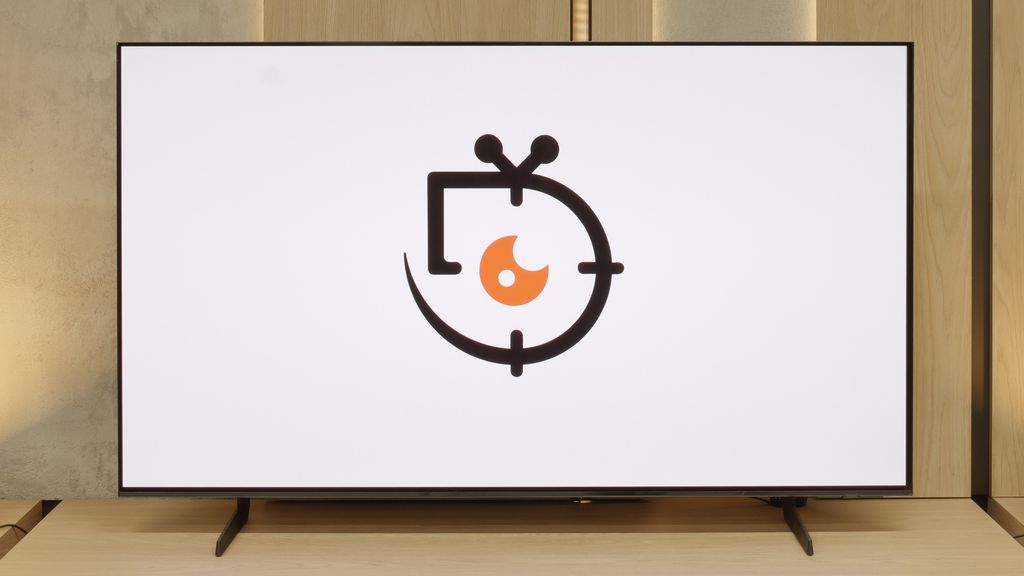
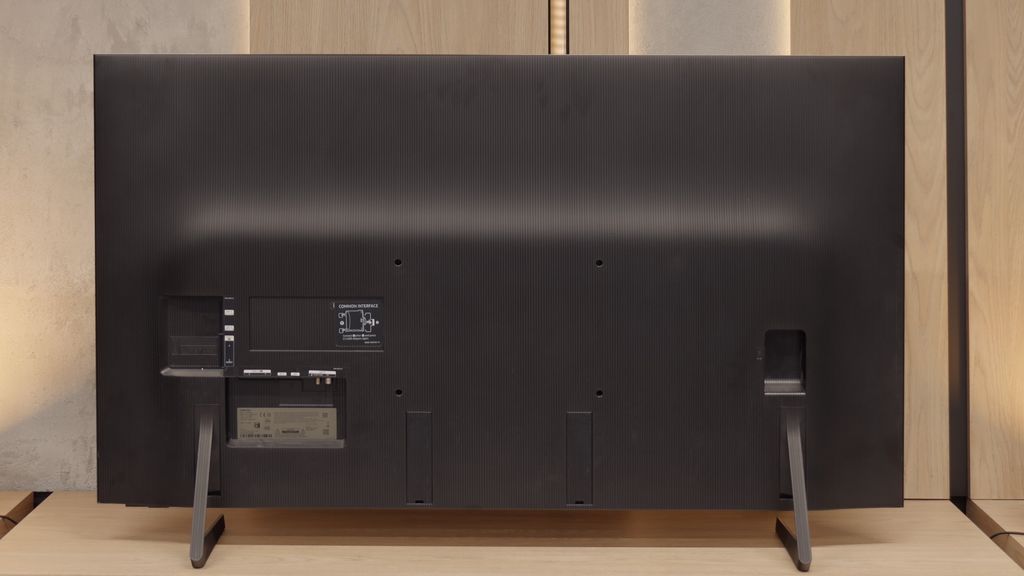
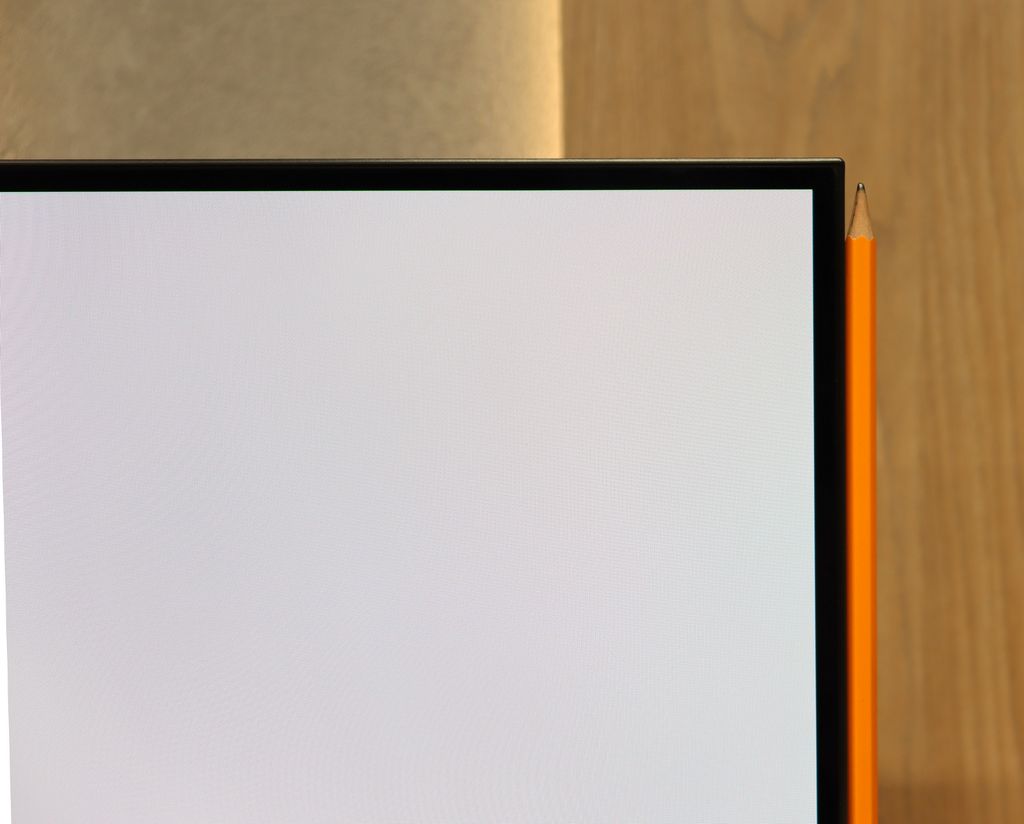
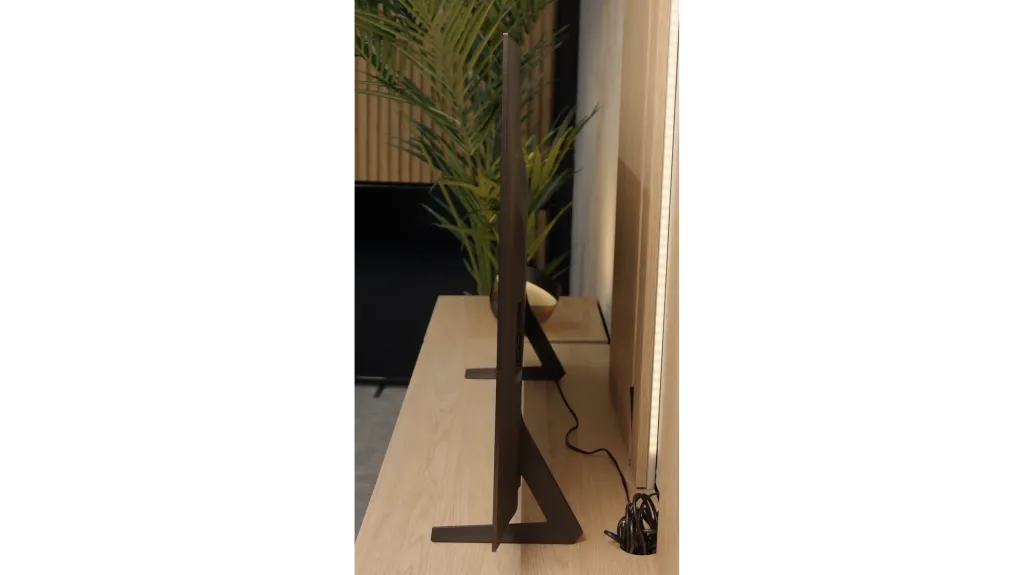




Contrast and black detail
10/10
10/10
Contrast:

Result
∞:1

Result
∞:1

Result
∞:1

Result
∞:1

Result
∞:1

Result
∞:1

Result
∞:1

Result
∞:1

Result
∞:1

Result
∞:1
Halo effect and black detail visibility:
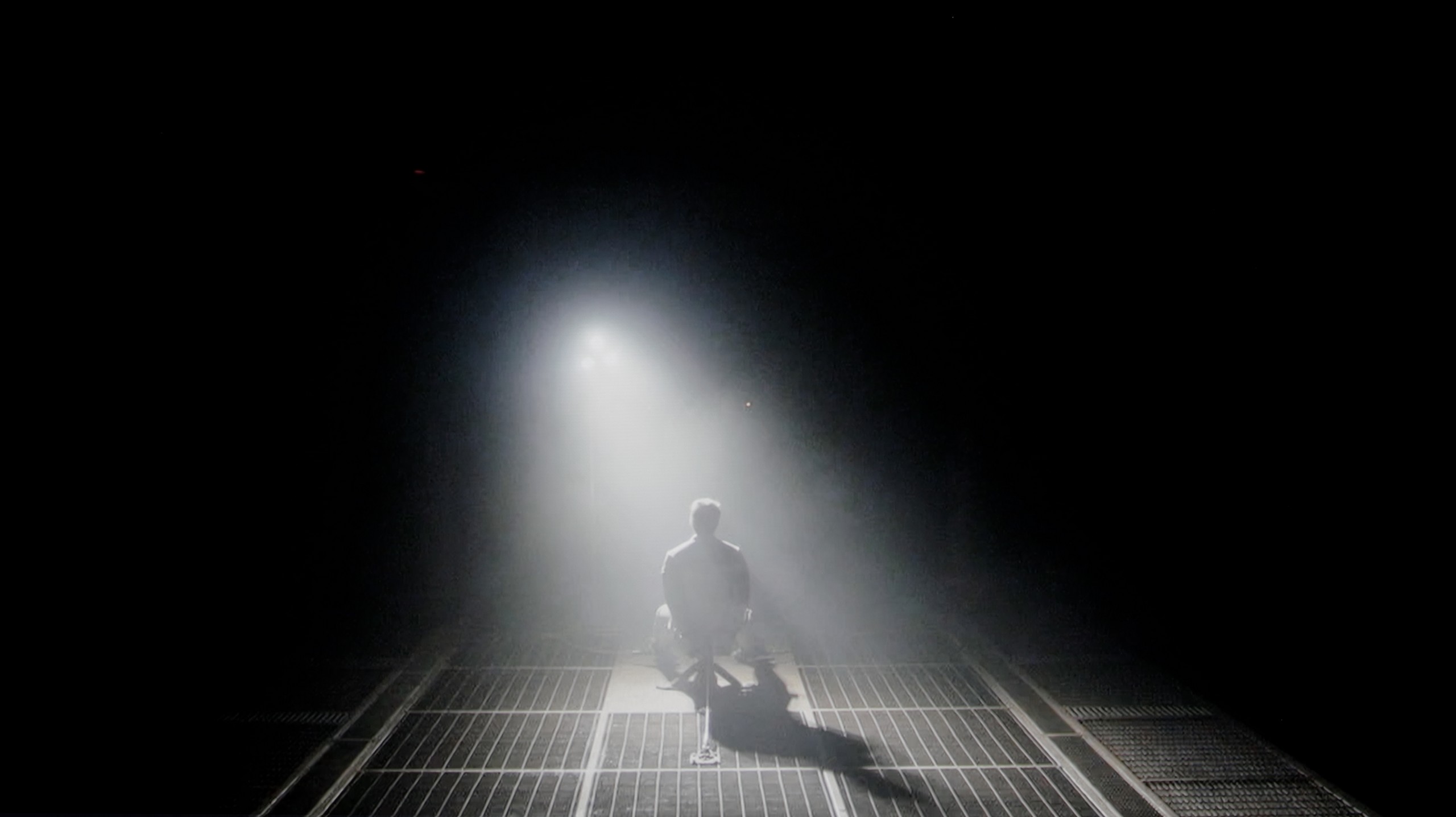

Samsung S85F in the 55-inch version has something special – it features a QD-OLED panel. This might sound quite surprising, but that's the fact, at least in Poland. So the question arises: is the difference compared to last year's S85D with a WOLED panel even noticeable? Yes, although in this specific test – black levels and contrast – it practically makes no difference.
Regardless of the scene, the S85F presents infinite contrast and perfect blacks that we expect from any OLED. These results can impress even the most demanding film enthusiasts. It's worth remembering that only TVs with organic panels can provide such deep blacks – and it doesn't matter whether it's WOLED or QD-OLED. So if you dream of a screen that can 'turn off' the light in a scene just as effectively as a boutique cinema in a dark room, the S85F is one of those TVs.
In terms of black and contrast, the Philips OLED770 doesn’t introduce any revolutions – but with OLEDs, it would be hard to expect one. The organic matrix allows for complete blacking out of individual pixels, which in practice gives us almost perfect black and contrast that reaches infinity. Whether we’re watching night scenes in films or scenes full of tiny bright points, the TV precisely separates details from the background. There are no halo effects or other artifacts typical for LCD TVs with local dimming here. Choosing an OLED – also in the version of model 770 – you can be assured that in this category, the image will look fantastic.
HDR effect quality
6.2/10
6/10
Luminance measurements in HDR:

Result
666 nit

Result
703 nit

Result
742 nit

Result
732 nit

Result
433 nit

Result
546 nit

Result
657 nit

Result
726 nit

Result
704 nit

Result
275 nit
Scene from the movie “Pan” (about 2800 nits)


Scene from the movie “Billy Lynn” (about 1100 nits)


Static HDR10


Dynamic: HDR10+
Dynamic: Dolby Vision


HDR luminance chart:
Philips OLED770
HDR luminance
Luminance of RGB colors
Samsung S85F OLED
HDR luminance
As an OLED, the Samsung S85F can shine – literally. In favourable conditions, it can generate brightness exceeding 750 nits. This is significant because most films are created with displays aiming for around 1000 nits. In practice, this means that in scenes with moderately large, bright elements, the picture can look absolutely stunning. However, it's not always so rosy. When an enormous amount of light appears on the screen – whether it's an expansive, bright background or an entire frame filled with white – the S85F must tone it down. Brightness can drop by even four times in such scenes. This limitation is well-known to anyone familiar with OLEDs in this price segment, so we don't view it as a particular fail. However, something that deserves praise is what sets this model apart from the competition – colour gamut coverage. Thanks to the QD-OLED panel, our colour meter indicated values exceeding 100% coverage of DCI-P3 and an impressive 86% for the ultra-wide BT.2020 palette. Such results are hard to find even in televisions that cost several times more.
The Philips OLED770 doesn't try to compete with the brightest OLEDs on the market, and it's actually hard to expect that, as it's the entry-level model in Philips' range for 2025. In our measurements, it reached a maximum of around 700 nits, which allows for enjoyment of HDR effects in scenes where light appears in spots – for instance, in the flash of headlights or a starry sky. In such moments, the picture can truly amaze. However, it's different when there are more bright elements on the screen. The TV, like many cheaper OLEDs, restricts luminance at that point, and the entire image noticeably dims. This was best seen in a scene from the movie The Meg, where the sun rises behind an oil platform – the brightness dropped to around 250 nits, which is almost three times less. The HDR effect remains pleasing to the eye, but it's worth being aware that this model performs best in scenes with less intense light. Fortunately, the OLED770 also has an ace up its sleeve – the coverage of the DCI-P3 colour palette is as high as 99%, so colours in movies and games are vibrant and very close to what the creator intended.
Factory color reproduction
5.5/10
6.2/10


Factory Mode
After calibration


Factory Mode
After calibration
Samsung, as befits a manufacturer with ambitions, has equipped the S85F with a mode called Filmmaker. Its task is simple: to make the colours on the newly purchased television as faithful as possible to what the director intended to show us. Sounds great… but, as is often the case, a theory that sounds wonderful doesn’t always translate into perfect practice.
In the tested unit, it quickly became apparent that the image – due to an excess of blue and red – looked as if someone had gone a bit overboard with the saturation. As a result, there were quite significant colour errors, particularly in 4K content. On top of that, there was an issue with brightness – the S85F could brighten most scenes more than it should, stripping them of the intended mood.
Fortunately, Samsung televisions, including the S85F, offer an impressive number of settings for advanced calibrators. This means that we could see what this panel is really capable of when it gets into the right hands.
The first measurements already show that the factory settings of the Philips OLED770 have a lot to improve, even in Filmmaker mode. The white balance chart clearly indicates a lack of blue, giving the image a slightly yellowish tint. In practice, white is not snow-like, but leans towards warmer hues – which some may even find appealing, but from a precision standpoint, this is a deviation from the norm. The gamma, on the other hand, tends to be on the darker side – the average value is around 2.6 instead of the reference 2.4. In mid-tones, the image appears muted and more saturated, which can look too "cinematic" but detracts a bit from the naturalness. However, the most significant issues are visible in colour reproduction. The average error is relatively high, and some colours – particularly shades of grey – deviate significantly from what should be seen. In everyday viewing, this means that sometimes colours may look less natural than we would wish.
Color reproduction after calibration
9.3/10
9/10




Thanks to the huge number of settings in the menu, we managed to bring the S85F almost to perfection. White balance in SDR content? Literally perfect – deviations do not exceed a value of "1". So we can confidently say that in materials with not too high dynamics, we have an image that's close to reference.
In HDR content, minor issues appeared, but they don't have much significance in practice – most errors fall below the threshold of perception, which is a value of "3". We also managed to tame the S85F when it comes to brightness management – the EOTF curve, even in films, holds nearly perfect straight line. This is one of those cases where after calibration, you can comfortably forget about the settings and simply watch movies and series at the highest level.
Philips OLED770 had shown signs from the start that it harboured significant potential, but it was hard to fully appreciate this in its factory settings. The image was often too warm, and some colours appeared as if they had lost their naturalness along the way. Calibration revealed that this television was very amenable to work – it responded to every adjustment and almost immediately unveiled another layer of its capabilities. The white balance was set in both SDR and HDR so that the yellowish haze disappeared and a neutral, clear white emerged. Gamma stabilised closer to perfection, which helped restore the naturalness of mid-tones, while shadows ceased to be artificially darkened, perhaps even with a slight brightening effect. The result was obvious... Movies are watched with greater ease; the image has cinematic depth without the feeling that something is overly darkened. However, the most interesting aspect was working on the colours. Factory errors were not dramatic, but slightly noticeable – skin tones could be too warm, and grey wasn’t always the shade we expected. After calibration, the error values dropped to around 2, and in many cases even below 1. This is a level that is definitely lower than the threshold of discernibility for the human eye. In other words, after correction, the colours finally “clicked” into place. Looking at the screen, we felt like the television had begun to speak with a full voice. Like an instrument that had finally been properly tuned.
Smoothness of tonal transitions
7.9/10
7.6/10












Thanks to the QD-OLED panel, colour blending on the S85F is really very good. It's particularly worth noting how it performs in the darkest, most demanding scenes – where most TVs start to struggle, this model operates almost perfectly.
Interestingly, a slight stumble can be noticed in those easier, brighter shots. There is minimal colour banding, but it's so subtle that it's hard to believe it would genuinely bother anyone during viewing.
In this category, there’s a noticeable improvement compared to last year's Philips models. The OLED770 handles colour gradation significantly better, and strongly visible transitions or artificial banding occur less frequently than before. Interestingly, we achieved the best results in dark scenes – where most televisions, especially those with WOLED panels, tend to struggle the most. A good example is the shot of an actor floating in red water – the transition from intense red to black looks nearly perfect here, without the typical “stair steps.” The situation is somewhat worse in light parts of the image. With extremely bright gradients, particularly close to white, the television has trouble maintaining smoothness. This can be noticed, for example, in a scene from the film Kingsman, where in the background of the bright sky with the sun, subtle bands of the sunrise appear instead of a smooth blur. Fortunately, these situations are relatively rare, and in everyday viewing, the OLED770 presents itself very solidly and doesn’t disrupt immersion as was the case in last year's models.
Image scaling and smoothness of tonal transitions
7/10
7/10
Smooth transition function
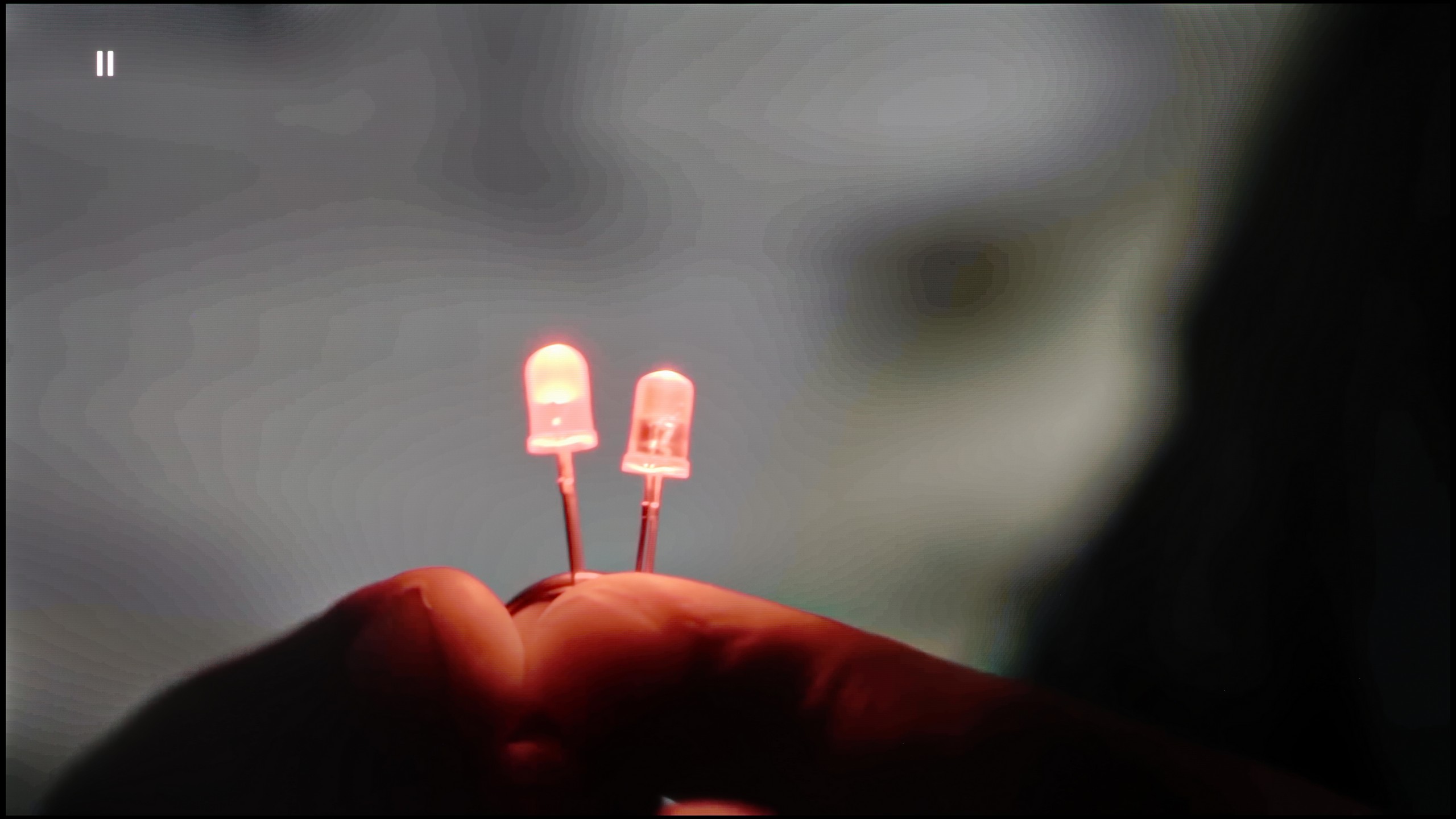

Image without overscan on the SD signal


The tone transition smoothing function in the S85F works really effectively – it can completely eliminate the problem of visible banding in very poor quality material, such as from YouTube. Unfortunately, even the lowest level of this option comes with compromises. The noise reduction is so aggressive that it can smooth out film grain, which many of us consider to be an element of the cinematic atmosphere. At the “Standard” level, we didn’t notice this function removing anything significant from the image, so we can recommend this setting. On the other hand, the “High” level is a different story – it can smooth out not just noise, but also small, desirable details like, for example, the texture of objects.
When it comes to image scaling, the S85F performs very well. The material looks sharp, and the only slight imperfection is the barely noticeable aliasing of edges. And there’s the ongoing issue with Samsung televisions – overscan. This can cause some scenes to be slightly cropped, which is worth noting when watching very old content.
The problem of the previously mentioned colour connections can largely be mitigated thanks to the "distortion reduction" function, which is an algorithm for smoothing tonal transitions in Philips. It works best at a low level – effectively eliminating unwanted colour bands while not introducing strange artifacts or losing image detail. This is one of those features that is truly worth keeping on.
The issue of upscaling is somewhat less impressive. Images from lower resolution can be too soft, while in some parts the characteristic "jaggies" appear. The impression is that the algorithm is trying to reconcile two contradictory directions – smoothing and sharpening – and ultimately fails to find the golden mean. As a consolation, it's worth noting that the television does not have problems with overscan, meaning it does not cut off the edges of the image, which can sometimes happen in other competing models.
Blur and motion smoothness
8.5/10
8.4/10
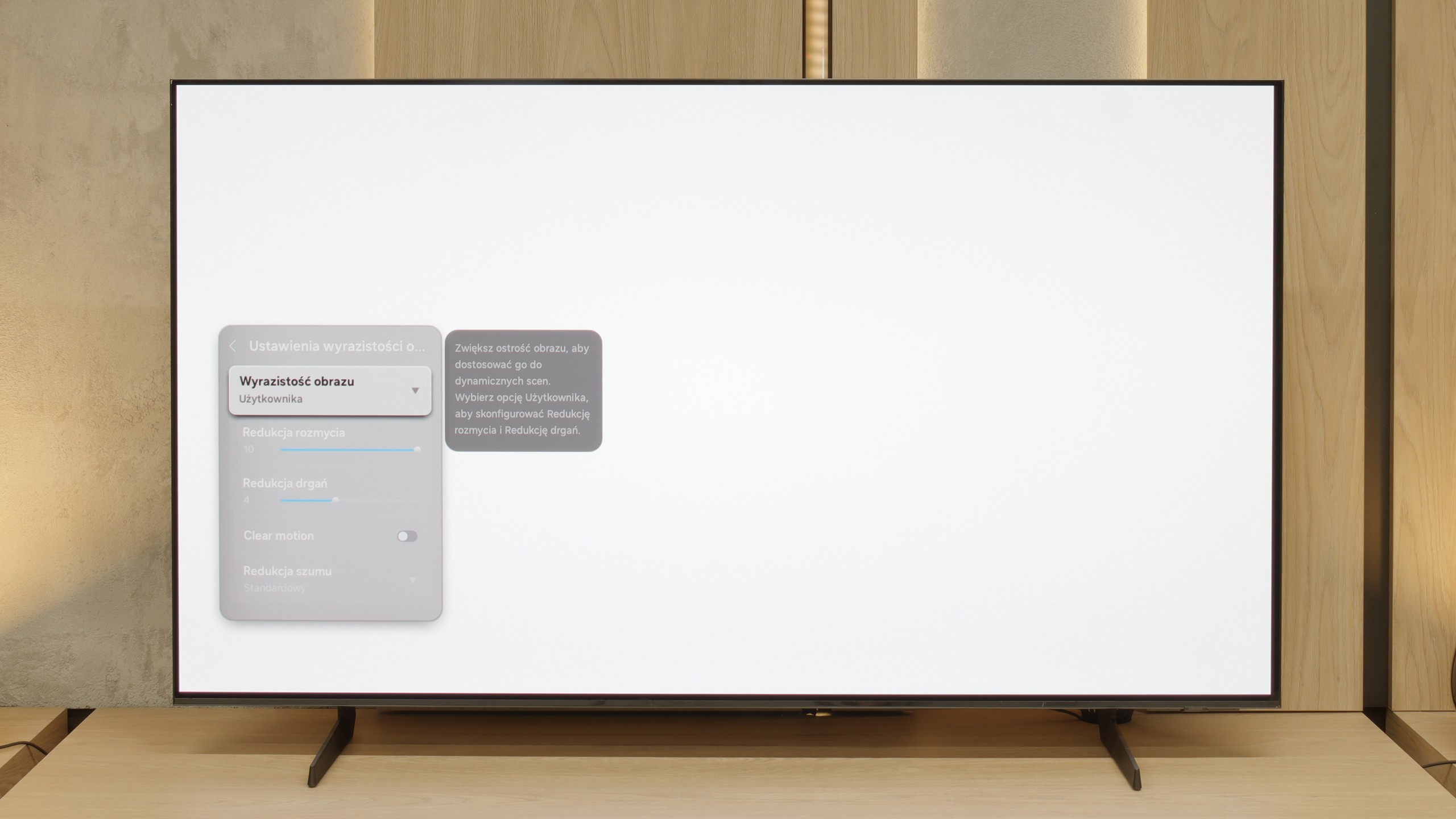

Blur (native resolution, maximum refresh rate):






Blur (BFI function enabled):
Image flickers in this mode



Smużenie (4K@60Hz Game Motion Plus):



Smużenie (4K@144Hz):



S85F is an incredibly fast television – and that’s not just empty hype. Thanks to the 120 Hz OLED panel, dynamic scenes, whether in games or while watching a live match, look just as they should – smooth, sharp, and without the feeling that something is "slipping" out of frame. The lightning-fast pixel response time, typical of OLEDs, plays a big role here. Transitions between frames are virtually instantaneous, and the image remains clear even during the fastest camera movements. A ball flying across half the field? A car speeding in a chase scene? Everything here is clear and free of the typical "trail" associated with LCDs.
This is exactly what we expect from a good OLED – zero compromises when it comes to motion smoothness. The S85F gives the impression that regardless of the pace of action, we can focus on what’s happening on the screen, rather than on the imperfections of the image.
The issue of the panel in the Philips OLED770 is not entirely straightforward. The manufacturer claims a 120 Hz panel, but our measurements showed that the screen can accept a 4K signal even at 144 Hz. This sounds like great news – because who wouldn't want an additional mode for PC gamers at this price? However, the reality turned out to be more complex. With 120 Hz content, the television behaves like most OLEDs – the image is absolutely clear, with no trace of blurring or smearing, ideal for both dynamic games and sports broadcasts. The problem only arises at 144 Hz. Unlike models with official support for this frequency, here we see the phenomenon of so-called frame skipping. This means that the television is unable to display all the frames – some of them are skipped, causing motion to lose smoothness and double outlines to appear on the screen. The effect resembles the operation of the BFI function, which Philips does not offer in this model anyway.
Console compatibility and gaming features
8.2/10
10/10
- ALLM
- VRR
- VRR range48 - 120Hz40 - 120Hz
- Dolby Vision Game Mode
- Correct implementation of HGIG
- 1080p@120Hz
- 1440p@120Hz
- 4K@120Hz
- Game bar
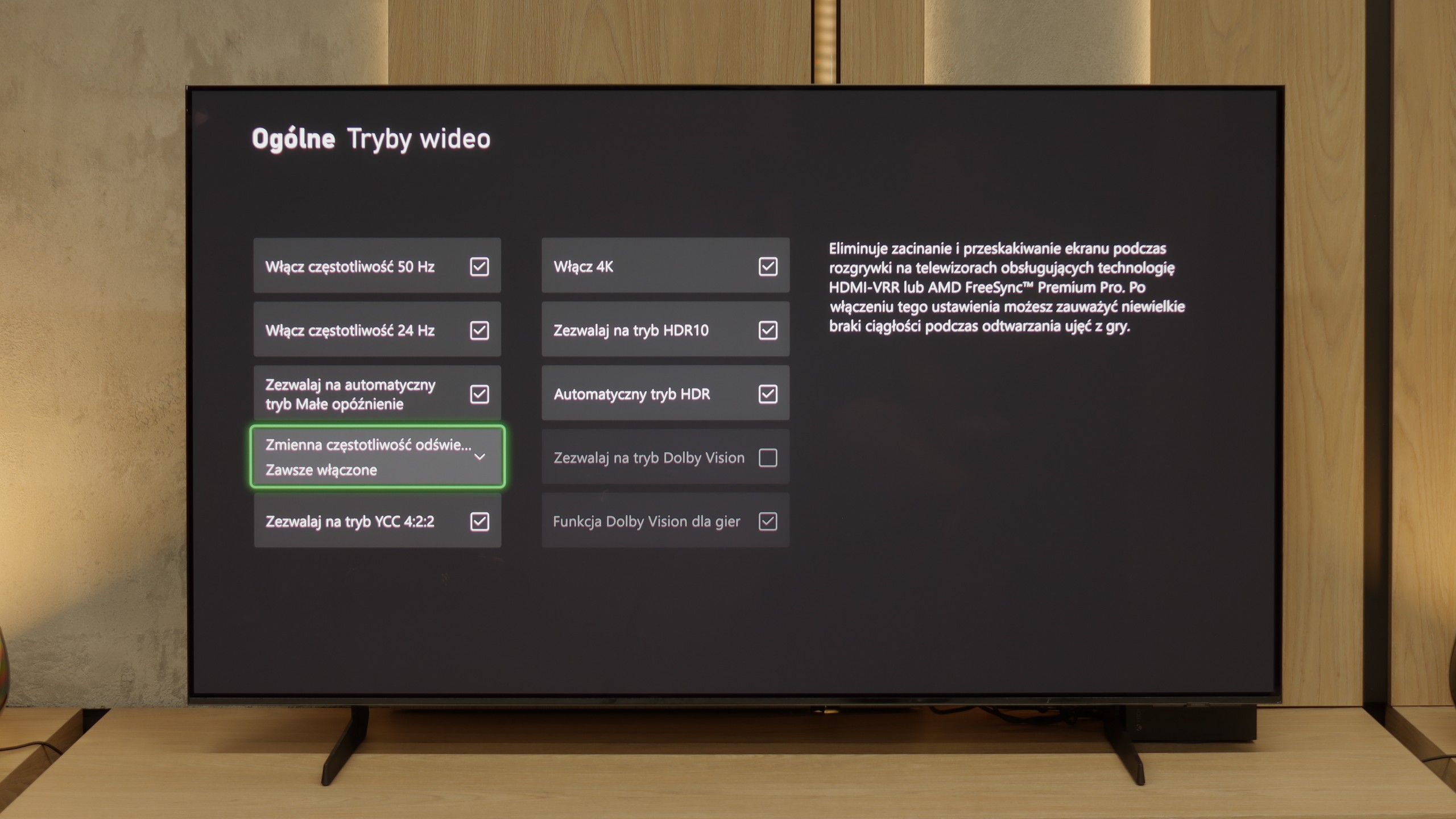

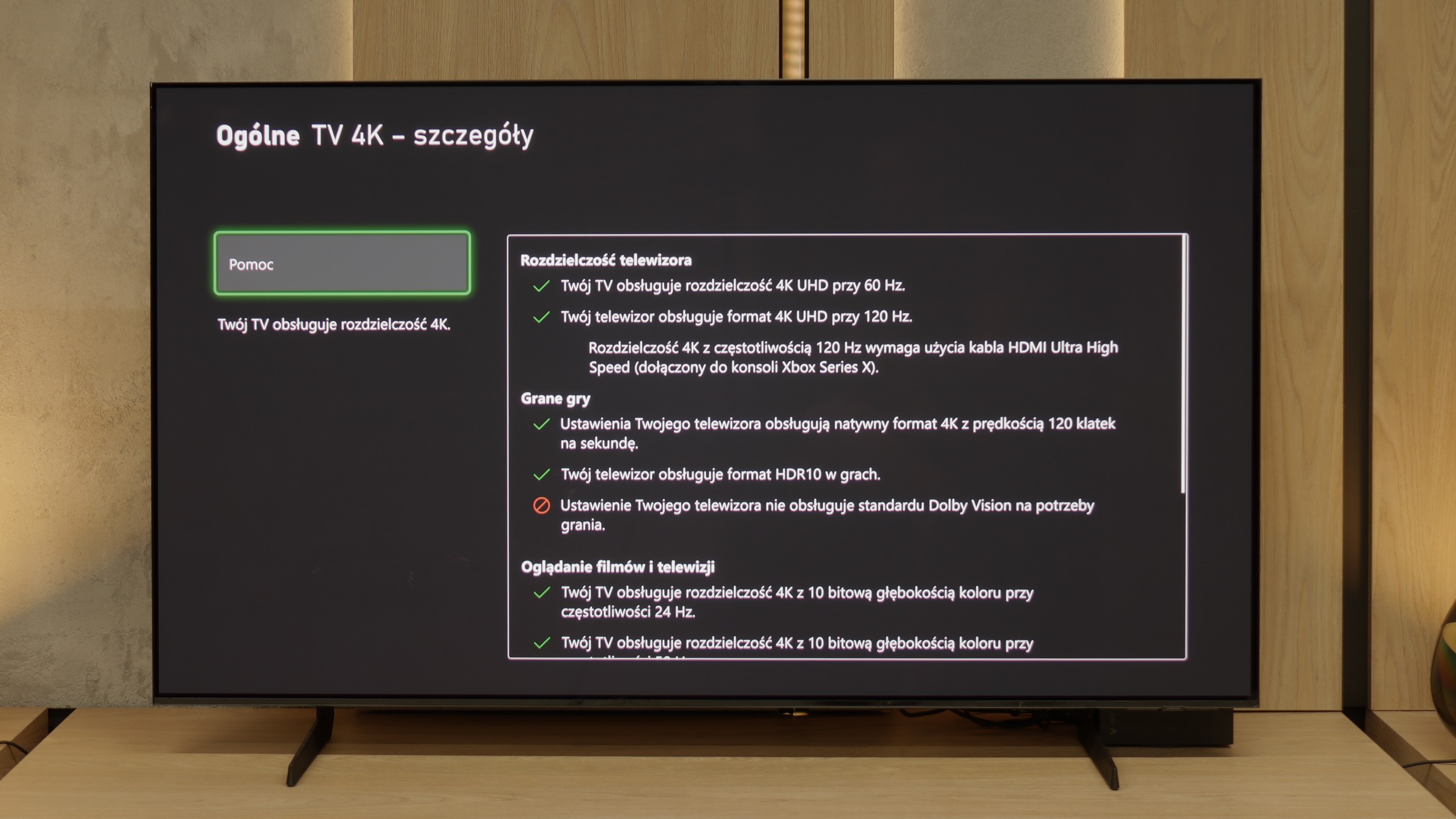

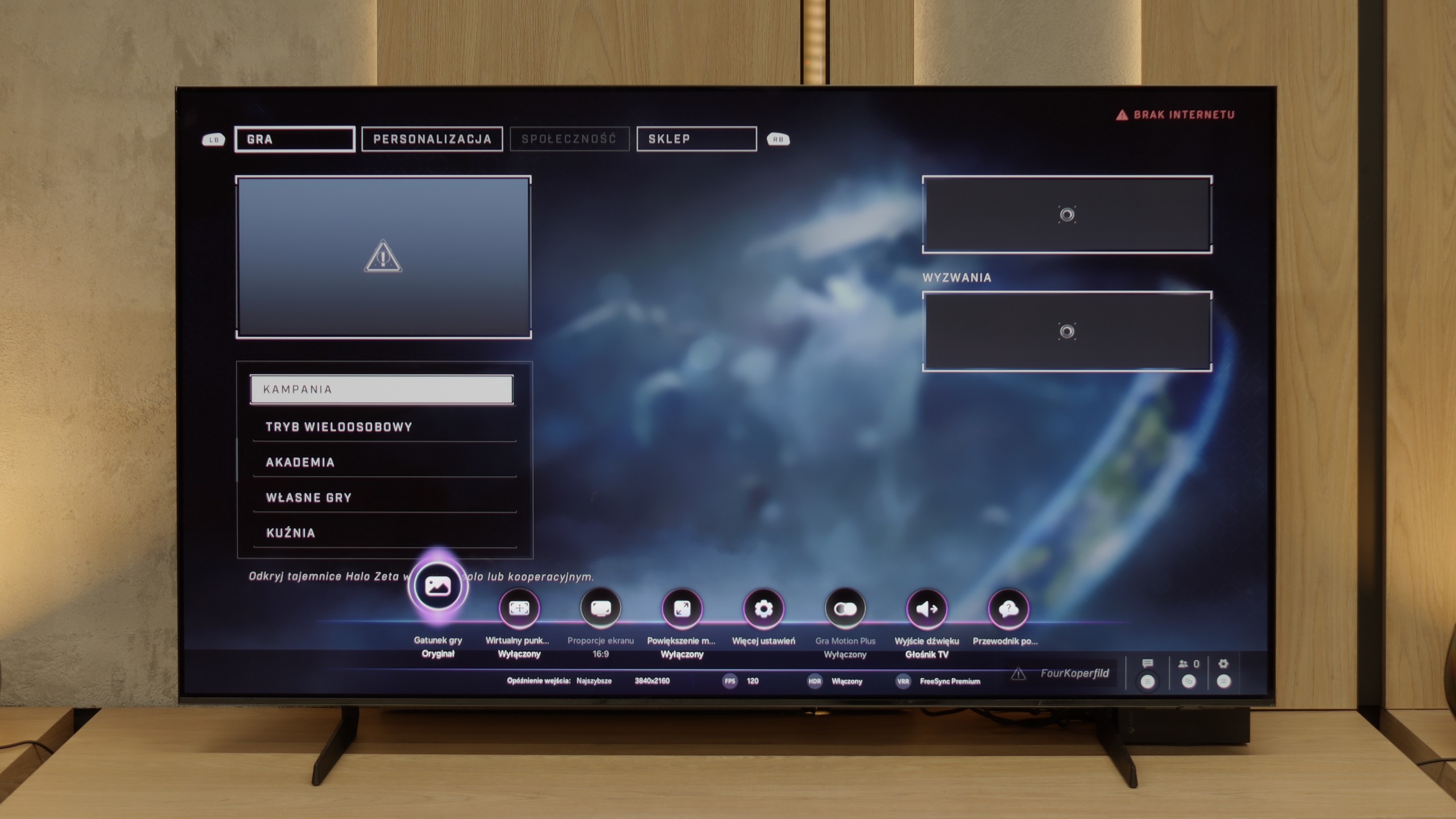

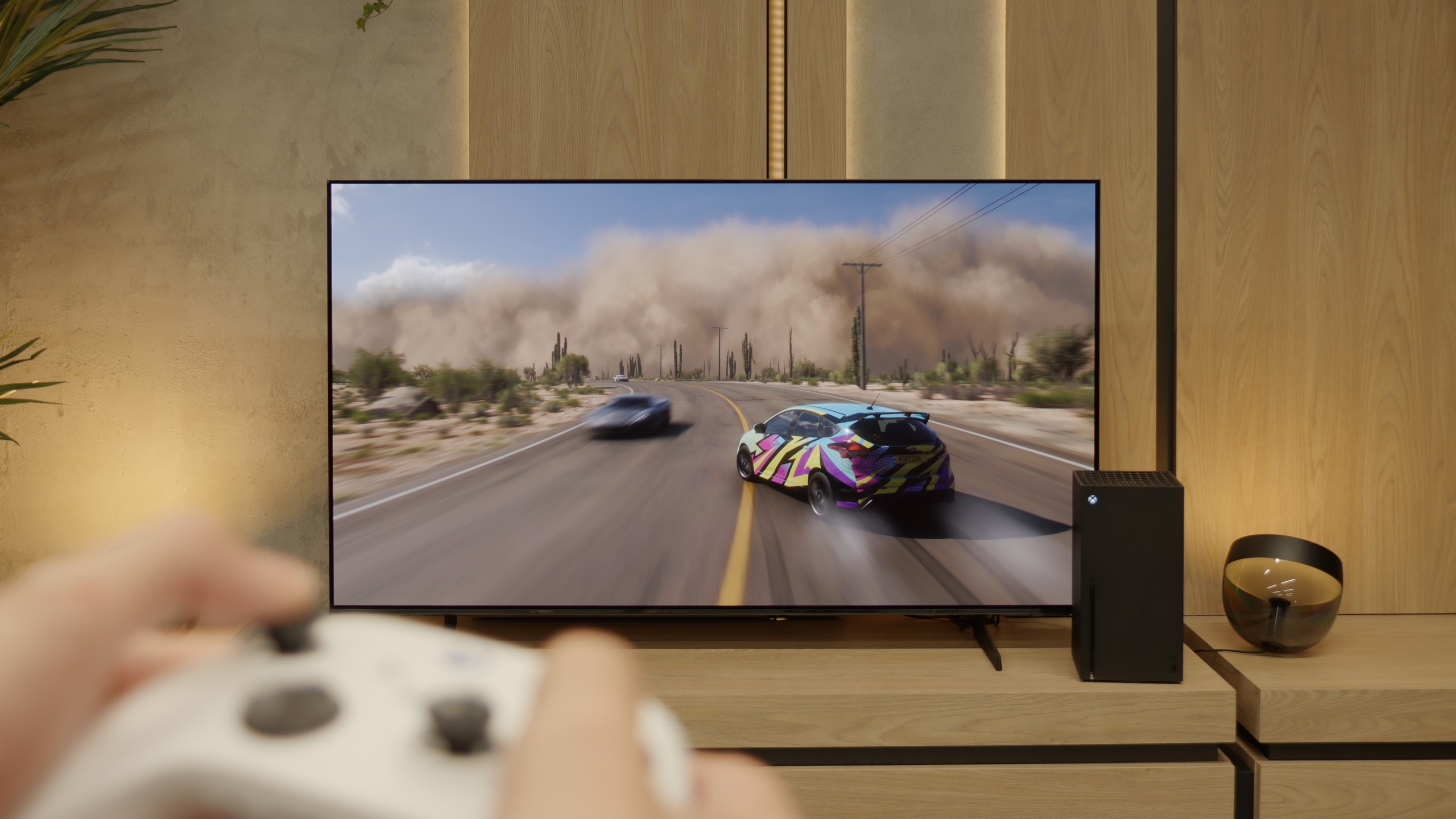

S85F has practically everything on board to become the dream screen for gaming. Four full HDMI 2.1 ports with a bandwidth of 48 Gb/s, support for VRR, ALLM, a super-detailed Game Bar that clearly shows all parameters – plus a gem in the form of Game Motion Plus. This motion smoother makes animation in games more enjoyable, while input lag increases slightly. It's a rare combination, and that’s a big plus for Samsung.
Perhaps Samsung will fix this in the next update – and we have high hopes for that. Because if HGiG comes back, the S85F will become nearly the perfect TV for gamers.
If someone is looking for a TV for gaming, the Philips OLED770 is a candidate that's hard to overlook. The mere fact that this is an OLED gives it a great starting point – perfect blacks and infinite contrast make evening sessions in atmospheric games look like they've been taken straight out of a cinema. Added to that is the Ambilight system, which uses LEDs on the back of the TV to extend the image onto the wall behind the screen. The effect is such that even just playing FIFA can look like a small spectacle, and in horror games, the atmosphere becomes really thick. On the technical side, it's also quite decent. The Philips OLED770 supports variable refresh rate (VRR) up to 120 Hz, has an automatic mode for gamers (ALLM), and for those using an Xbox Series X, Dolby Vision support in games is also available. You just need to know that in this mode, the input lag is slightly higher than standard, although still at an acceptable level. As a bonus, we also get the 'Game Bar', which is a special tool strip for gamers. It's not the most conveniently designed solution, but it allows for a quick view of key parameters without exiting the game. Overall, this gives a picture of a TV that has all the most important gaming features on one hand, and on the other can add something unique – Ambilight. And it's this mix of technology and visual effect that makes the OLED770 one of the better screens for gaming in a home environment.
Input lag
10/10
9.8/10
SDR
HDR
Dolby Vision
Here, dear gamers, the S85F shows its claws. 5 ms with 120 Hz content and around 10 ms with 60 Hz are results that can be described in one word in the world of televisions – phenomenal. This means that the response to our movements is practically instantaneous. We press the button, and the action on the screen happens without any delay, as if the television can read our thoughts. In dynamic games, where a fraction of a second can decide victory or defeat, such values make a huge difference. There's no question of a nervous "wait" for the image to catch up with our movements. The S85F gives us the feeling that everything is under our complete control – and that's how it should be in equipment that aspires to be the ideal screen for a gamer.
As we mentioned earlier, the only anomaly that has been captured during testing is the Dolby Vision Gaming mode. In this setting, the latency can reach up to 30 ms. This is not a particularly impressive result, and more demanding players may turn up their noses, but in practice – during casual sessions – the difference will not be greatly noticeable. The standard HDR10 and SDR modes perform much better, however. In the case of a 120 Hz signal, the input lag drops to a minimal 5 ms, which is an outstanding result and places the OLED770 among the top TVs suitable for dynamic gaming. In other words, if someone isn’t set on Dolby Vision on Xbox, the gaming experience will be fast, smooth, and free of unnecessary delays!
Compatibility with PC
7.6/10
7.6/10
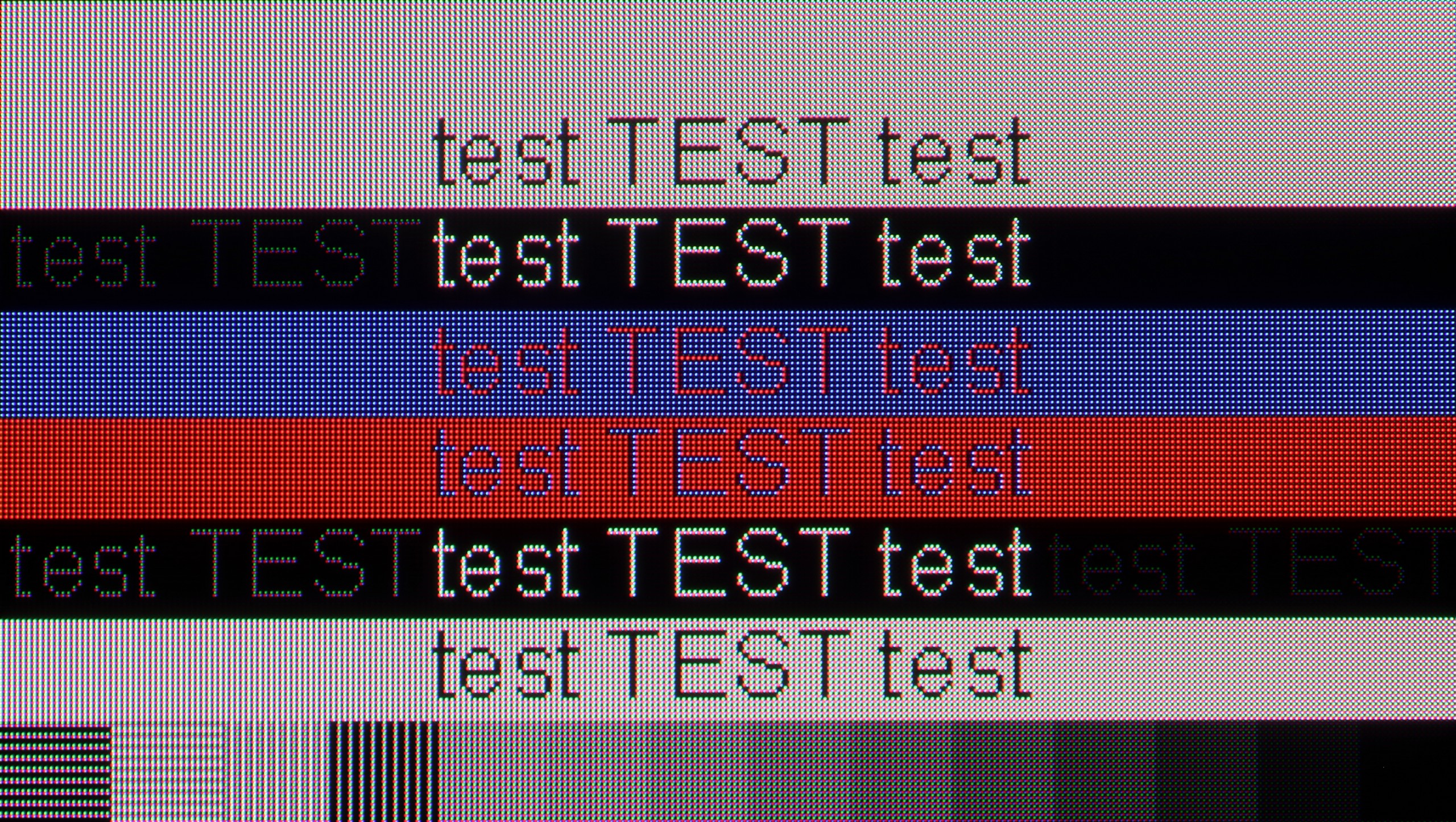

If you're planning to connect the S85F to a computer, we have good news – this television is perfect for that. Low input lag and a 120 Hz panel make gaming on PC a pure pleasure. Whether we're talking about dynamic shooters or more relaxed RPGs, the response is instantaneous, and the smoothness of the animation can draw you in for hours on end.
Of course, there’s no rose without thorns. Due to the diamond pixel layout in the QD-OLED panel, there is a slight "rainbow icon" effect, particularly noticeable when sitting close to the screen. Fortunately, this is more of a detail that most of you won’t mind in everyday use. Especially since, thanks to the proper implementation of 4:4:4 chroma, the readability of fonts is at a very good level – documents, websites, and text editors simply look as they should.
Philips has learned from previous models and has finally improved the implementation of chroma 4:4:4. This is important news for those planning to connect the TV to a computer, as it means no problems with sharpness and readability of fonts. Text looks clear and crisp, so the OLED770 can easily be called an excellent display for office work or browsing the internet. Of course, very demanding users may notice some imperfections resulting from the WRGB pixel arrangement typical of WOLED panels, but in practice, this does not significantly impact comfort. The TV also performs well in games launched from a PC. The panel allows for real refresh rates of up to 120 Hz, and with low input lag, this provides a very smooth image without noticeable stutters. The only thing missing is support for G-Sync and – as we mentioned before – a proper 144 Hz mode, but despite that, the overall performance is really solid. For those looking for a versatile screen for computer and console use, the OLED770 is a choice that’s hard to underestimate.
Viewing angles
9.8/10
7.7/10
Here, dear readers, the S85F reaches the absolute peak. The viewing angles are phenomenal – some of the best you can get in a TV today, and it’s thanks to the unique QD-OLED panel from Samsung Display. Of course, WOLED panels can also maintain a high level in this regard, but let’s not kid ourselves – what the QD-OLED shows in the S85F is even more impressive. Colours, contrast, and brightness remain practically unchanged even when viewing the screen from a very large angle. It’s the kind of television where you don’t have to fight for the “best spot on the couch” – everyone will see the picture in all its glory, no matter where they’re sitting.
In terms of viewing angles, the Philips OLED770 presents a very high level typical of OLEDs. The image remains readable and saturated even when viewing the screen from the side – there is practically no drop in contrast or fading of colours. In this category, it only falls short of QD-OLED panels, which we find either in very expensive premium models or in one exceptional case – in the 55-inch Samsung S85F. However, in everyday use, the differences are difficult to detect, and the OLED770 performs nearly perfectly. Only at really extreme angles can a slight degradation of colours be noticed.
TV efficiency during daytime
5.1/10
4.8/10
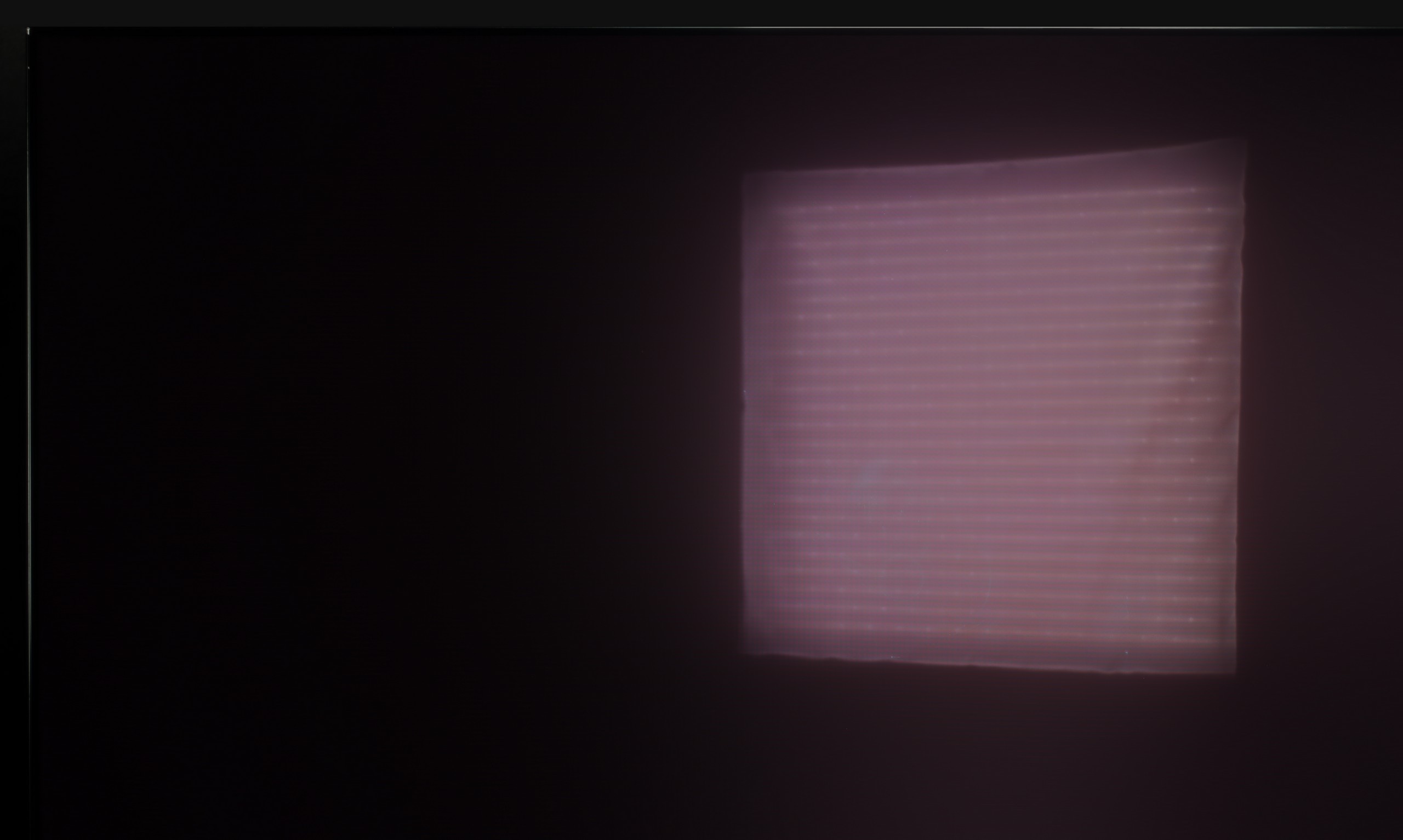



Matrix brightness
Average luminance SDR
Philips OLED770: 249 cd/m2
Samsung S85F OLED: 317 cd/m2
We really liked the saying "no rose without thorns," and it fits perfectly with QD-OLED TVs. Especially when we look at their performance in highly lit conditions. As you may notice, under very intense light, the surface of the panel can take on a slightly cherry hue. The effect is subtle in the case of the S85F, but in extreme lighting conditions, black can appear a bit worse than in WOLED panels. But – and this "but" is key here – QD-OLED suppresses direct light reflections much better. This means that reflections will be less bothersome, and the picture will retain clarity even when something bright reflects on the screen. You win some, you lose some.
As for brightness, the S85F is a moderately bright OLED. It’s not a model designed for extremely sunny living rooms. If you plan to place it in a very bright room, we recommend considering blinds or placing it in a location that at least partially protects it from direct light.
OLED770 is not one of the brightest TVs, so it's hard to recommend it for very sun-filled living rooms. In a bright room, its limitations quickly become apparent – the screen catches reflections and behaves more like a lightly dimmed mirror. Glare reduction is average, and in direct light, the screen performs poorly. Fortunately, the panel's coating does not distort colours, so even during the day, the hues remain natural, and the blacks do not dramatically lose their depth. Nevertheless, it’s hard to say that the OLED770 is a TV designed for bright spaces – it will definitely find a better home in a dimly lit living room or in a bedroom, where its strengths can truly shine.
Details about the matrix
Subpixel Structure:
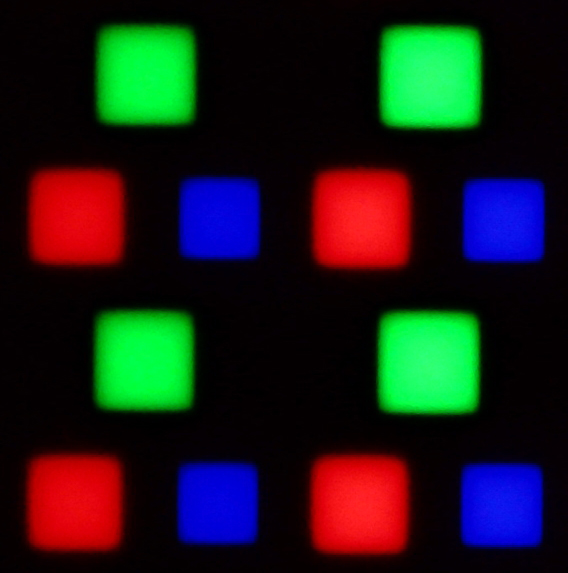

Panel uniformity and thermal imaging:


Samsung S85F OLED
Philips OLED770
TV features
7.3/10
5.5/10
- HDMI inputs0 x HDMI 2.0, 4 x HDMI 2.1 48Gbps0 x HDMI 2.0, 4 x HDMI 2.1 48Gbps
- Other inputsToslink (Optical audio)
- OutputsToslink (Optical audio), eARC (HDMI), ARC (HDMI)Toslink (Optical audio), eARC (HDMI), ARC (HDMI), Mini-Jack (Headphones)
- Network InterfacesWi-Fi 2.4GHz, Wi-Fi 5GHz, Ethernet (LAN) 100MbpsWi-Fi 2.4GHz, Wi-Fi 5GHz, Ethernet (LAN) 100Mbps
- TV receptionDVB-T, DVB-T2, DVB-S, DVB-S2, DVB-CDVB-T, DVB-T2, DVB-S, DVB-S2, DVB-C
Classic features:
- Recording to USB (terrestrial TV)
- Recording programming
- Picture in Picture (PiP)
- RF remote control (no need to aim at the screen)
- Backlit remote control
- Teletext
- Audio only mode
- Bluetooth headphones support
- Simultaneous Bluetooth headphones & TV audio
Smart features:
- AirPlay
- Screen mirroring (Windows Miracast)
- Voice search
- Voice search in native language
- Ability to connect a keyboard and mouse
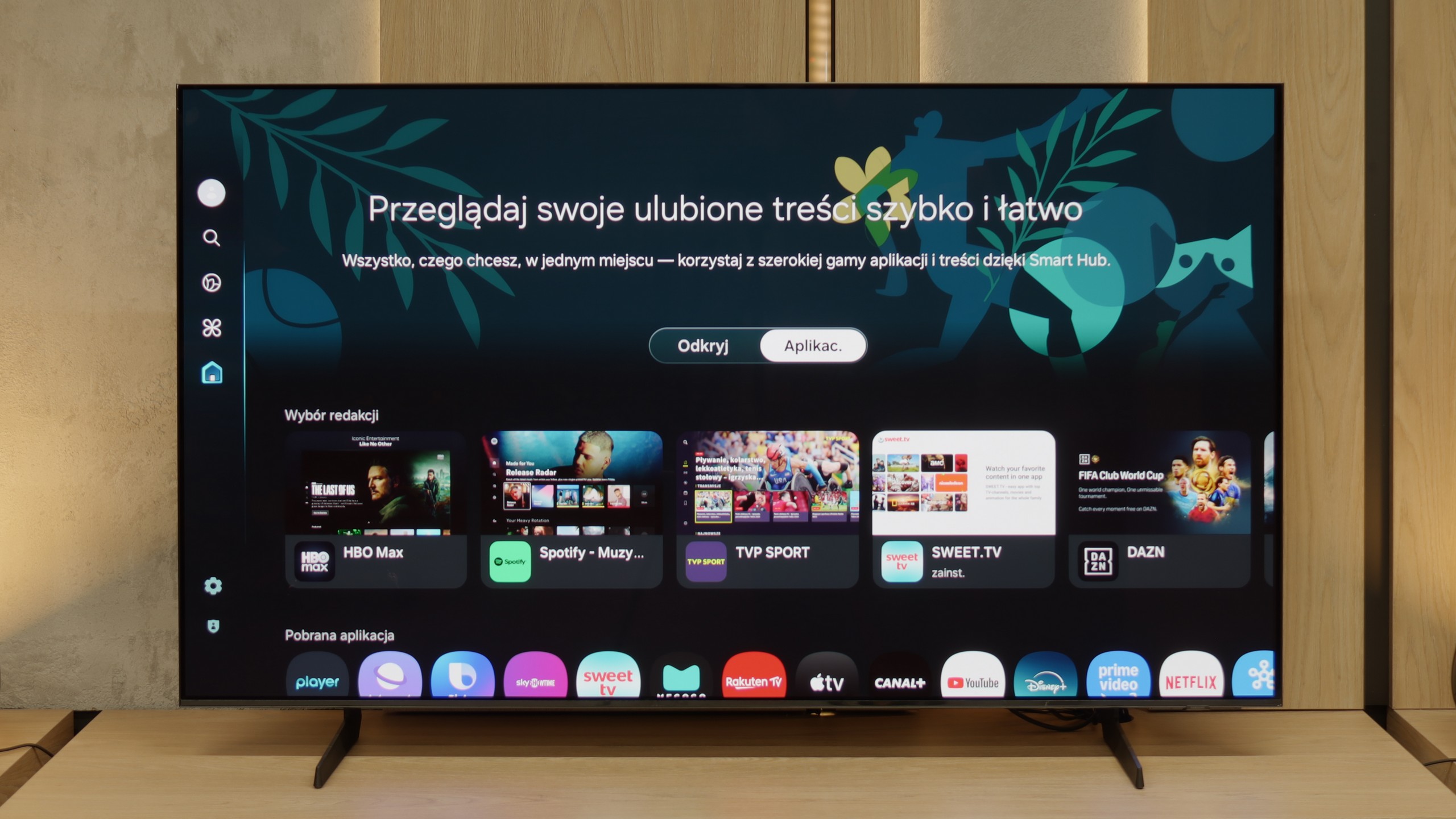
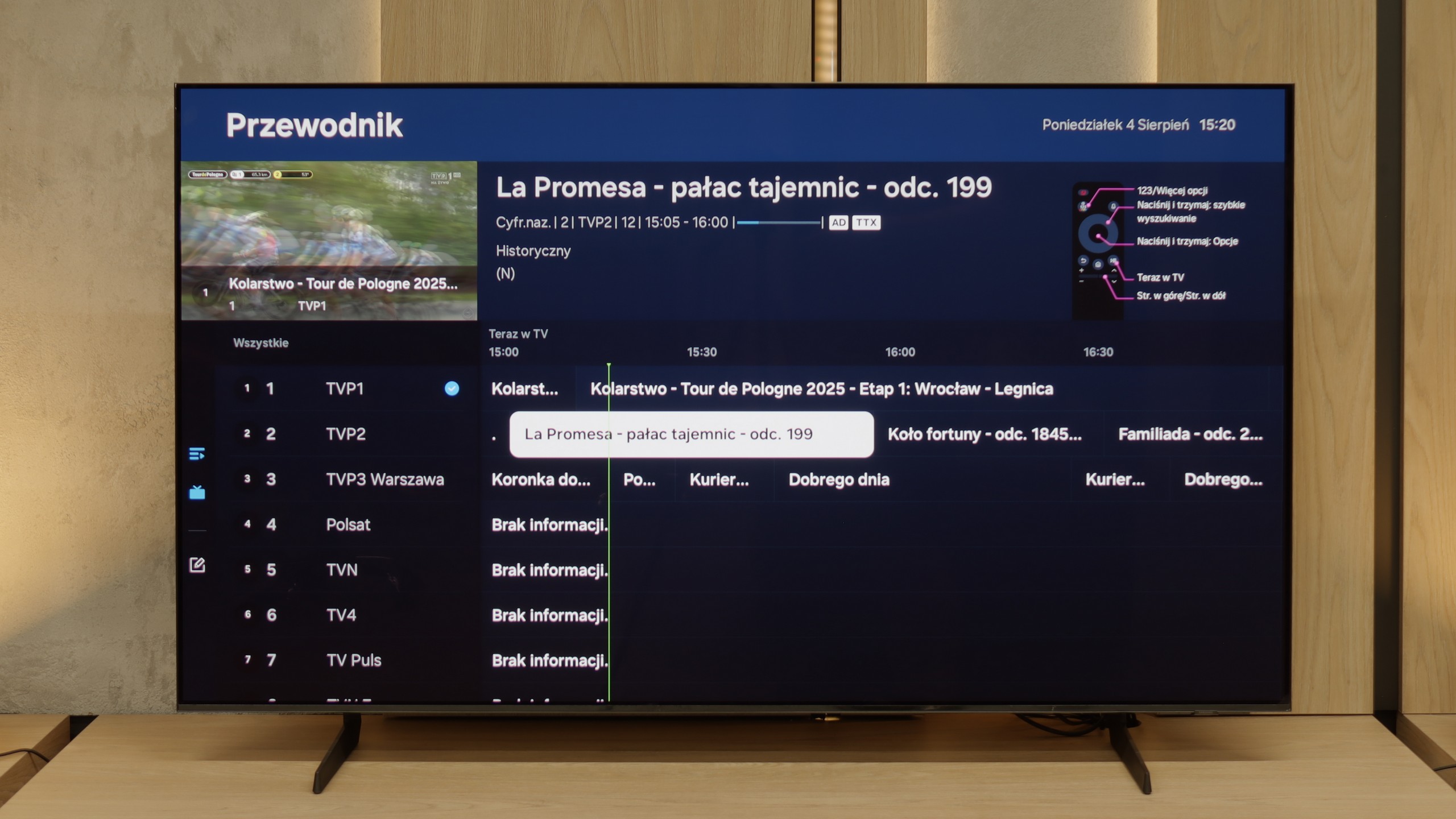
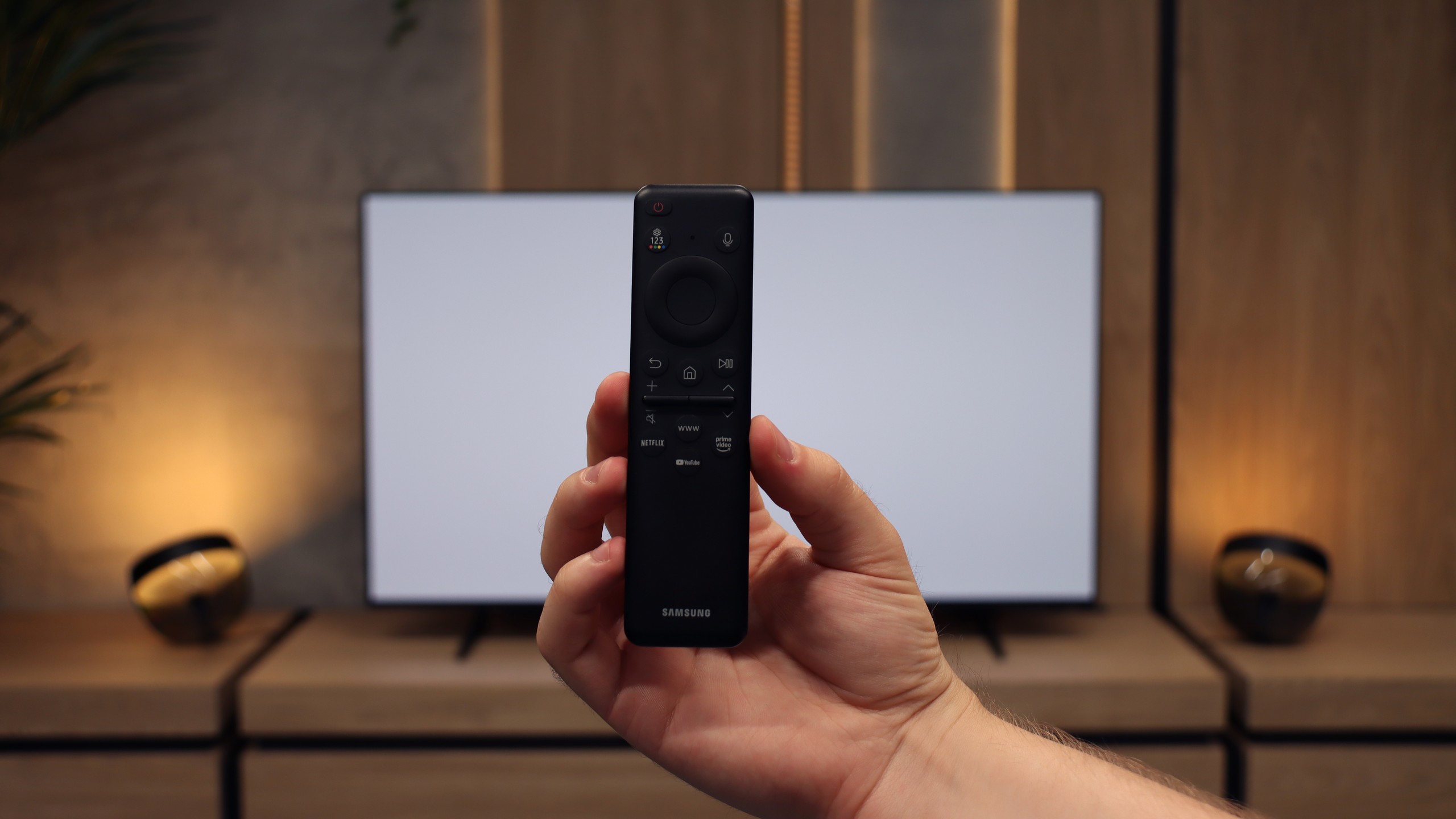
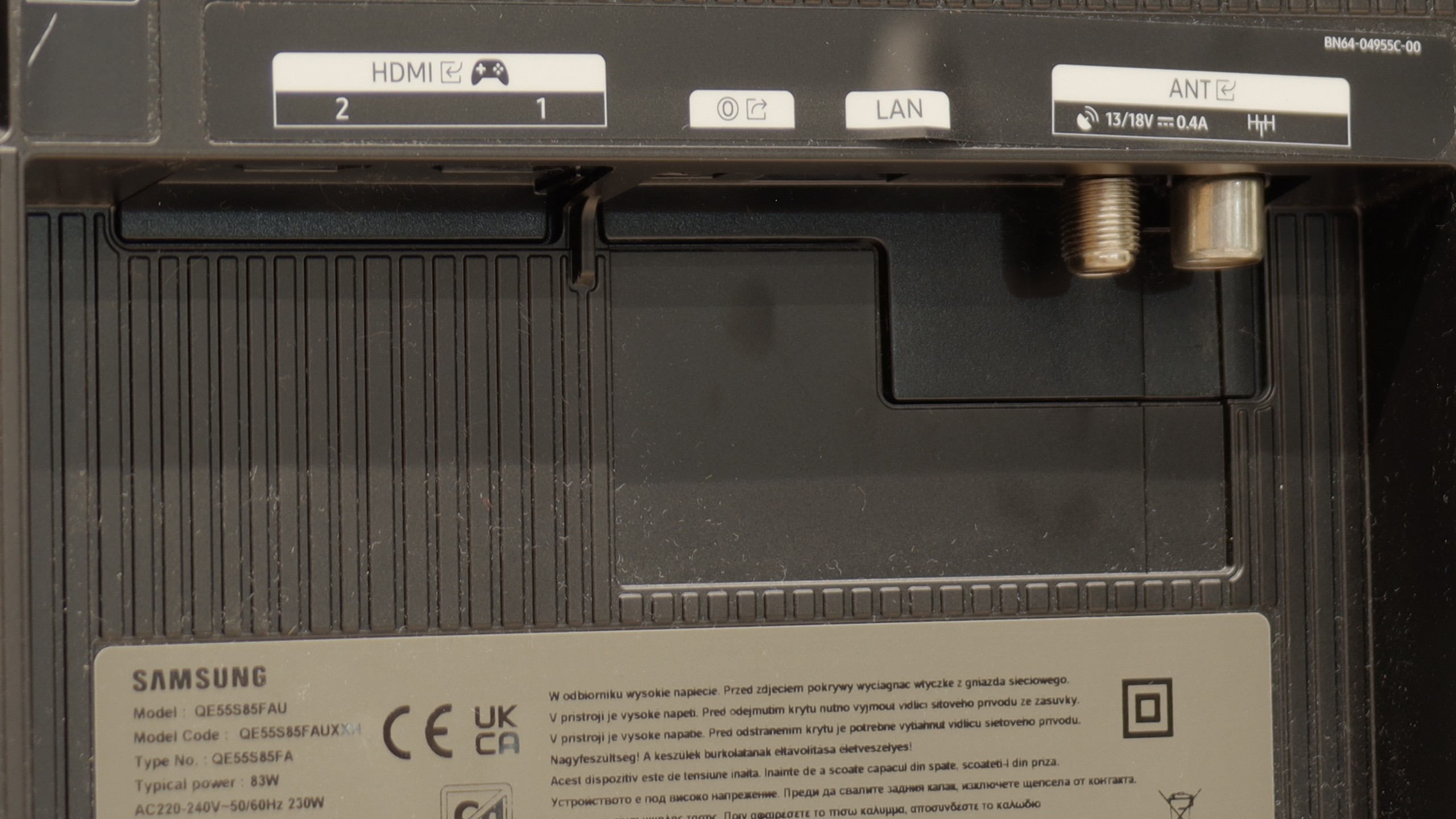




Features of the classic S85F television
The S85F was not really designed with fans of classic television in mind. We won’t find a PiP function here (which is somewhat surprising, as Samsung typically offers it) or the ability to record programs onto USB from the built-in tuners. Fortunately, the basics are there – teletext and a clear channel guide – so it’s more than sufficient for regular, everyday viewing. The included remote, although simple at first glance and lacking a numeric keypad, allows for control of multiple devices. This means that when connecting, for example, a Canal+ decoder, you don’t need two remotes on the table – the one for the television is quite enough.
SmartTV S85F: Tizen
The smart part is a completely different story. Tizen is one of the most comprehensive operating systems in televisions. It operates smoothly, supports all popular internet functions – from screen mirroring to AirPlay to voice search. The strongest point of Tizen is its integration with the SmartThings app, which can act as a control centre for the entire home. Of course, like any closed system, Tizen has its limitations – for instance, a smaller app library compared to GoogleTV. However, looking at the current list of available applications, it’s hard to point out anything that might actually be missing.
Functional Features
Let's start with the basics, which are the classic functions of a television. The Philips OLED770 doesn’t turn the table here; we have a standard EPG interface, the ability to connect devices via Bluetooth, and a few simple configuration options including teletext. Interestingly, there is a jack connection, which is becoming quite rare these days. However, those with older receivers or wired headphones will appreciate it. The remote creates a good impression – it’s ergonomic and has a backlit numeric keypad – but there’s also a sense of a step back here. It works via infrared, so you have to aim it at the television, and frankly, by 2025 we would expect full wireless support. The exception is voice commands, which use Bluetooth, but even here there’s no reason for euphoria.
SmartTV Features – TitanOS
Speaking of voice, let’s move on to the Smart TV system, which is an element that largely defines the daily comfort of using a television today. And here the OLED770 clearly lags behind the competition. TitanOS operates quickly enough that it's not a disaster, but daily use can be frustrating due to minor bugs and shortcomings. Theoretically, we get support for AirPlay, but on the other hand, screen mirroring just didn’t work at all in practice. Voice search? Yes, but only through Amazon Alexa and without support for the Polish language. In other words, the features are there, but when we try to use them, we find that their practicality is severely limited and nearly useless. And it’s this Smart TV aspect that becomes the greatest hindrance of the OLED770. The image can be astonishing, gaming is excellent, and Ambilight creates a unique atmosphere – but when we transition to daily use of apps and services, we feel a sense of dissatisfaction.
Ambilight – Philips OLED770
Although in terms of smart functionality, the Philips OLED770 is rather average, it has something in store that its competitors honestly envy. We’re talking about the three-sided Ambilight system, which has been a hallmark of this brand’s televisions for years. The LED lights positioned at the back of the housing dynamically illuminate the wall in colours matched to whatever is happening on the screen at that moment. The effect is simple but very suggestive – the image seems to extend beyond the boundaries of the television, giving us the impression that the screen has suddenly grown by extra inches. During a movie screening, it can create atmosphere, in games it enhances immersion, and during regular TV viewing, it simply pleases the eye. It’s this addition that makes it so that despite the limitations of TitanOS, the OLED770 has something that can attract attention and give it character.
Playing files from USB
9.1/10
8.5/10
Supported photo formats:
Maximum photo resolution:
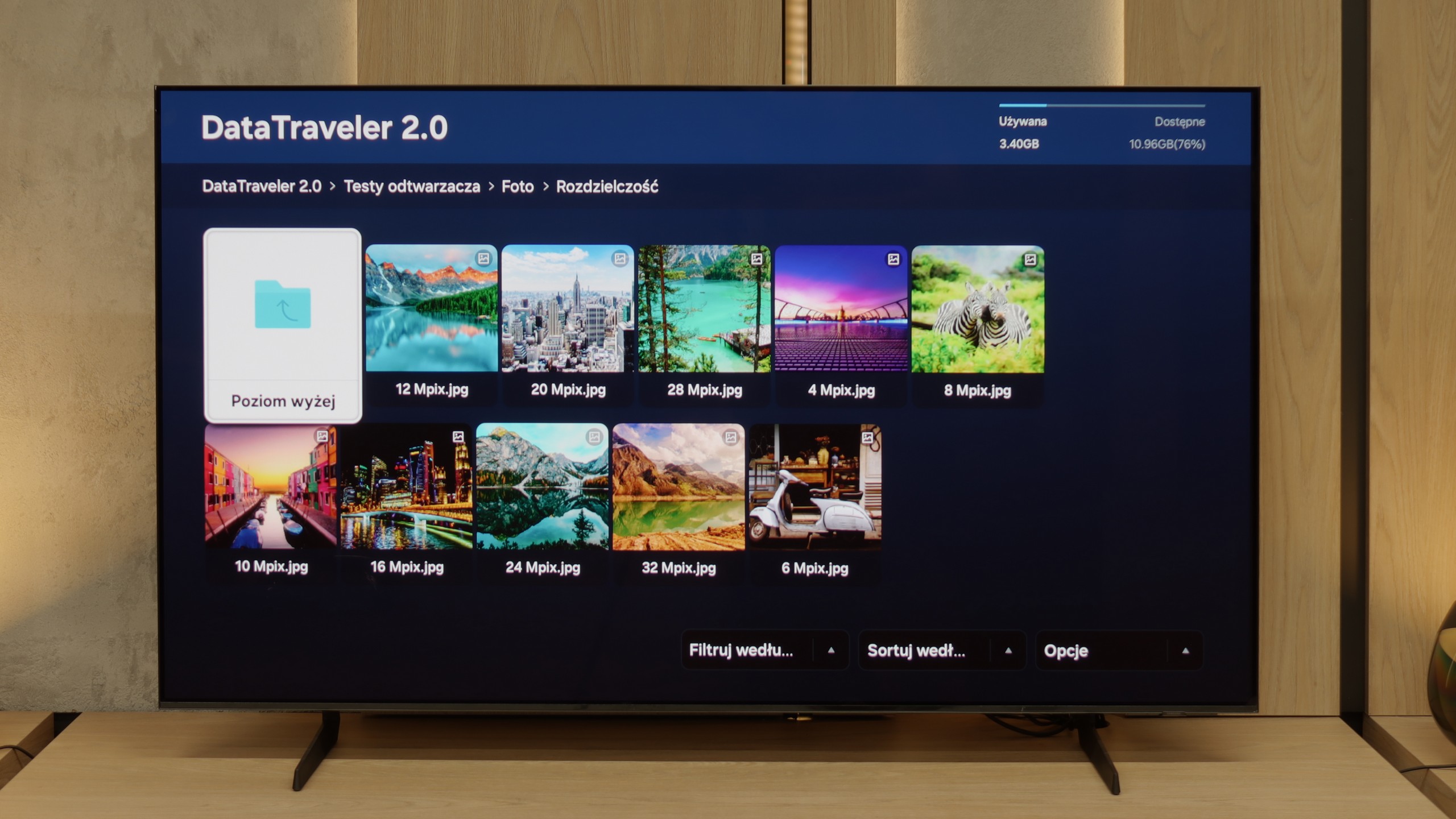

The built-in media player in the S85F performs excellently – practically everything you throw on a USB stick or hard drive will be played back without the slightest issue. Minor shortcomings only arise in the support of some less common photo formats, but for the vast majority of you, this will be more than sufficient. Therefore, it can be confidently stated that for home use, the built-in player is more than solid.
The built-in media player in the Philips OLED770 works quite well, especially when it comes to subtitles – virtually every format we threw at it was handled correctly, which will certainly please those watching films from their own library. However, there are certain reservations regarding photo support. Not all resolutions are recognised, which may surprise users accustomed to viewing photographs from traditional cameras or older memory cards. Apart from that, everything works correctly – it’s just worth ensuring that the TV can handle the files that we actually want to play on it.
Apps
8.7/10
6.7/10














































Sound
7.2/10
7/10
- Maximum volume80dB80dB
- Dolby Digital Plus 7.1
- Dolby True HD 7.1
- Dolby Atmos in Dolby Digital Plus (JOC)
- Dolby Atmos in Dolby True HD
- DTS:X in DTS-HD MA
- DTS-HD Master Audio
The built-in speakers rated at 20 W on paper may not seem impressive, but in practice, the S85F can be surprising. It sounds really pleasant, and at times you can even pick up a subtle bass, which is not a given in this class of speakers. The TV does not support the DTS format, which unfortunately became a standard for most manufacturers by 2025. A nice surprise is the support for Dolby Atmos. Of course, talking about "spatial" sound with two speakers located at the bottom of the casing would be a slight exaggeration, but it's good that Samsung offers such a feature in this model at all.
When it comes to sound, the Philips OLED770 performs quite well, although you can't expect powerful bass. For regular TV viewing, streaming services or series, its capabilities are more than sufficient – dialogues are clear, and the overall tonal balance is at a decent level. However, when we want to feel a real punch in cinematic productions or games, it quickly becomes apparent that it lacks solid low-end response. In such a situation, a natural complement becomes an additional soundbar or audio system that will allow you to take advantage of the potential of the excellent picture.
On the plus side, versatility in handling formats must be noted. The OLED770 can manage practically all popular codecs, including Dolby Atmos, DTS:X, and Dolby TrueHD. Because of this, when connecting external audio equipment, you can expect a full sound experience, even if the built-in speakers in the TV don't make a spectacular impression.
Acoustic Measurements
80dBC (Max)
75dBC
80dBC (Max)
75dBC


